1.10: Practice - Punnett squares and probability
- Page ID
- 73827
Query \(\PageIndex{1}\)
- Step-by-step solution
-
-
Because there are two traits here, we must perform a dihybrid cross. We know the parent genotypes (rrss and RRSS), but we need to figure out what the possible gametes are by figuring out all the possible combinations of the two alleles.
For the rrss mother, the only possible gamete combination is rs.
For the RRSS father, the only possible gamete combination is RS.
-
Next we will perform the dihybrid cross.
Cross: rrss x RRSS
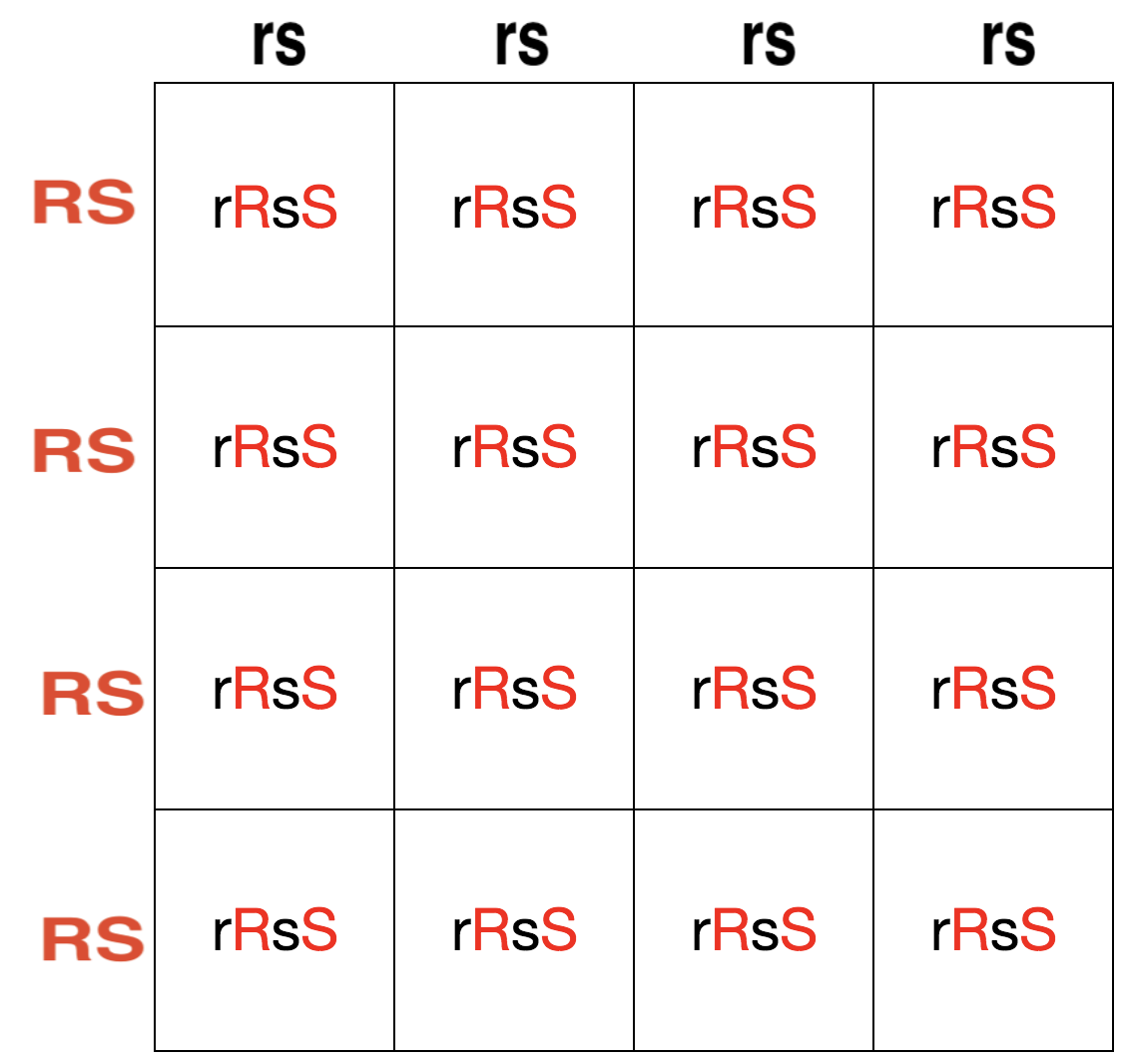
If we complete the cross, we find that the possible offspring can only be rSsR. Offspring that have at least one R and S allele must be rude and sneaky because the allele for rude (R) is dominant to the allele for respectful (r) and the allele for sneaky (S) is dominant to the allele for sincere (s).
-
After completing the Punnet square, we need to figure out how many of the offspring genotype combinations contain only the recessive r and s alleles because that is the only way to express the respectful and sincere phenotype combination.
Overall, there are 0 genotype combinations with only the recessive r and s alleles and thus, a 0/16 chance of offspring being respectful and sincere.
-
The correct answer is
0/16
-
Query \(\PageIndex{2}\)
- Step-by-step solution
-
-
The father is homozygous recessive (bb), so he can only give the recessive b allele to the offspring, while the mother is homozygous dominant (BB), so she can only give the dominant B allele to the offspring. The cross for these parents is bb x BB.
-
We can complete a Punnett square to find the possible offspring genotypes.
Cross: bb x BB
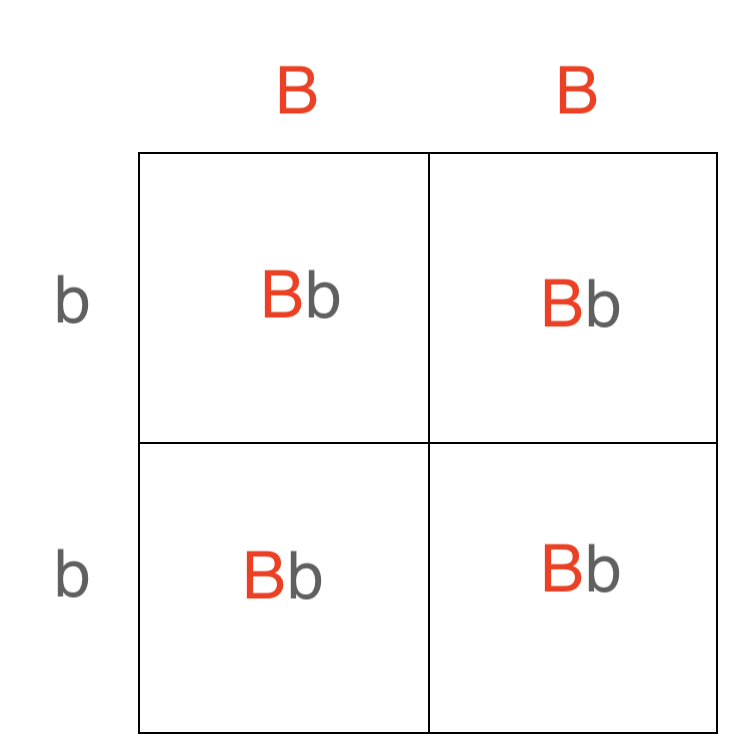
If we complete the cross, we find that the possible offspring can only be Bb. Offspring that have at least one B allele must be boring because the allele for boring (B) is dominant to the allele for busy (b).
-
If we complete the cross, we find that there is a 100% chance of the offspring being Bb (boring). There are no other possible genotype combinations.
-
The correct answer is
Only Bb
-
Query \(\PageIndex{3}\)
- Step-by-step solution
-
-
Because there are two traits here, we must perform a dihybrid cross. We know the parent genotypes (CcDd and CcDd), but we need to figure out what the possible gametes are by figuring out all the possible combinations of the two alleles.
For both parents, the CcDd genotype leads to the possible gamete combinations of CD, Cd, cD, or cd.
-
Next, we will perform the dihybrid cross.
Cross: CcDd x CcDd
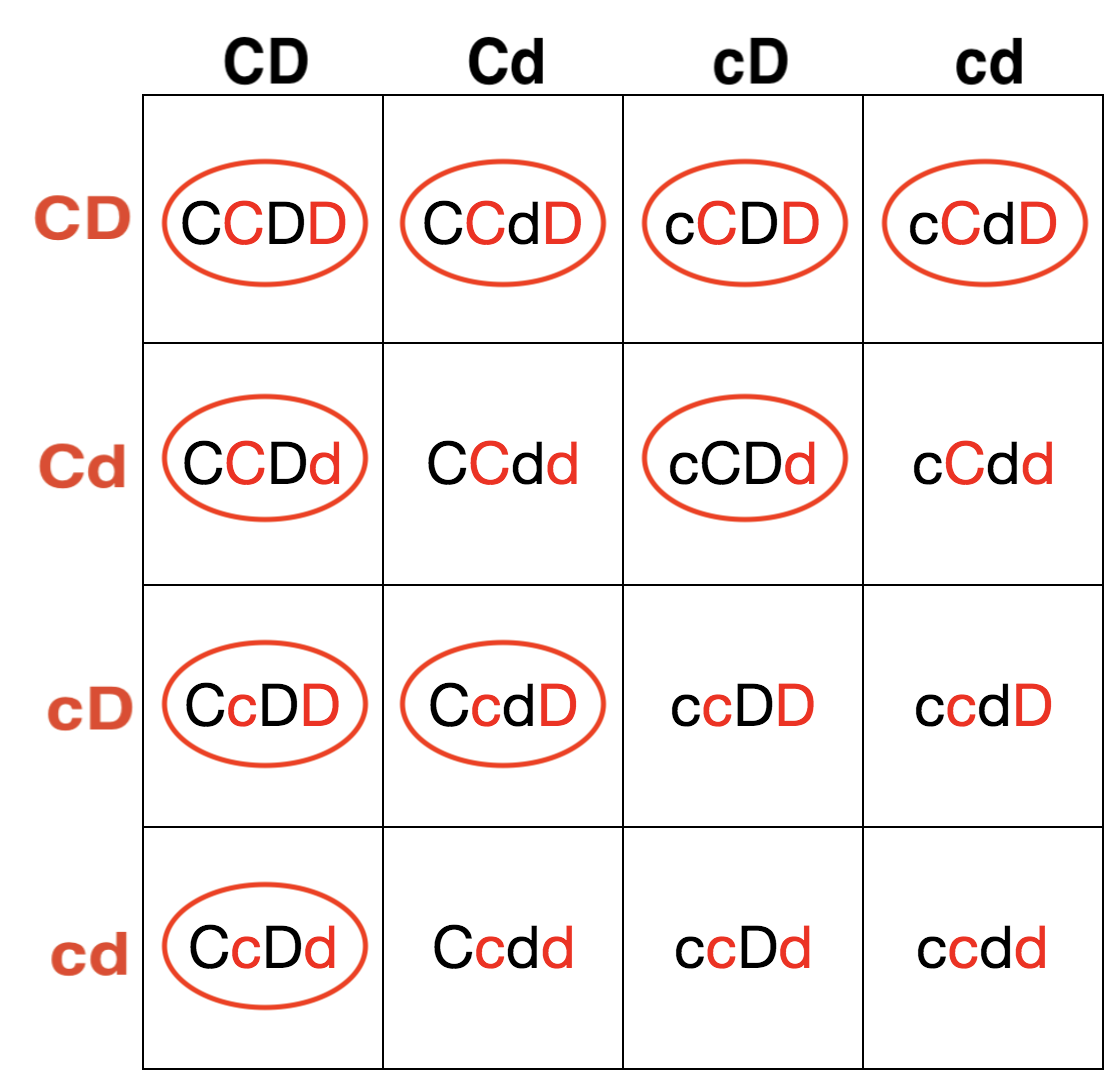
After completing the cross, we need to figure out how many of the offspring genotype combinations contain at least one dominant C allele and one dominant D allele in order to get the clumsy and dazzling phenotype combination.
-
Because we are looking for the proportion of offspring that are both clumsy and dazzling, we can refer to the circled genotypes in \({\color{Red} red}\) on the Punnett square. These boxes all contain at least one dominant C allele and one dominant D allele.
Overall, there are 9 \({\color{Red} red}\) circled genotypes and thus, a 9/16 chance of offspring being clumsy and dazzling.
-
The correct answer is
9/16
-
Query \(\PageIndex{4}\)
- Step-by-step solution
-
-
The mother is heterozygous, so she can possibly give one of either allele (P or p) to the offspring, while the father is homozygous dominant (PP), so he can only give the dominant P allele to the offspring. The cross for these parents is Pp x PP.
-
We can complete a Punnett square to find the possible offspring genotypes.
Cross: Pp x PP
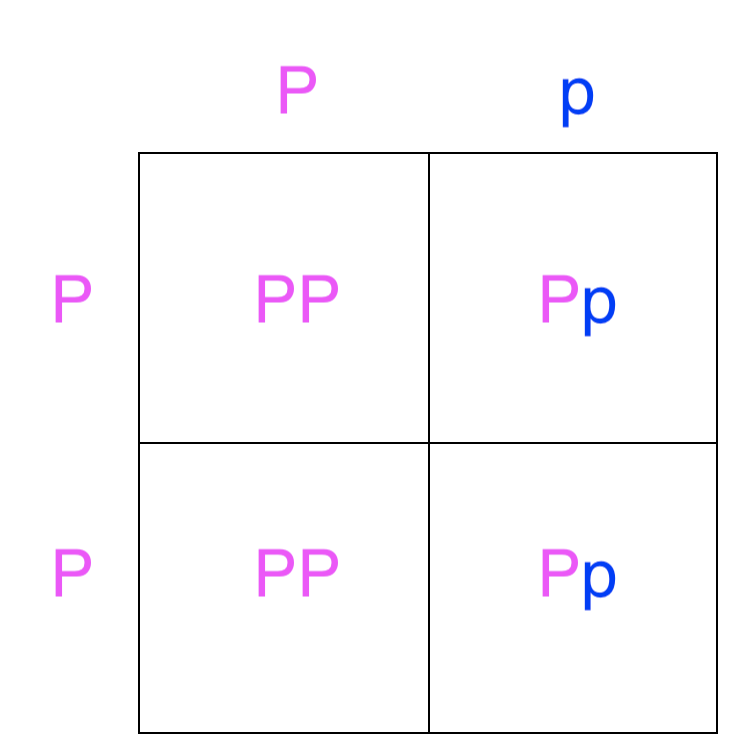
If we complete the cross, we find that the possible offspring can be PP or Pp. Offspring that have at least one P allele must be playful because the allele for playful (P) is dominant to the allele for paranoid (p).
-
If we complete the cross, we find that there is a 50% chance of the offspring being PP (playful) and also a 50% chance of the offspring being Pp (playful). There are no other possible genotype combinations.
-
The correct answer is
PP and Pp
-
Query \(\PageIndex{5}\)
- Step-by-step solution
-
-
Because there are two traits here, we must perform a dihybrid cross. We know the parent genotypes (Bbhh and bbHh), but we need to figure out what the possible gametes are by figuring out all the possible combinations of the two alleles.
For the Bbhh parent, the possible gamete combinations are Bh, Bh, bh, or bh.
For the bbHh parent, the possible gamete combinations are bH, bH, bh, or bh.
-
Next, we will perform the dihybrid cross.
Cross: Bbhh x bbHh

By completing the cross, we find that the possible offspring genotypes are BbHh, bbHh, Bbhh, or bbhh.
-
Because we are looking for the proportion of offspring that are brown with long fur, we need to identify offspring that are dominant for the fur color gene (either BB or Bb), and recessive for the fur length gene (hh).
If we look at our Punnett square, the only genotype that displays these phenotypes is Bbhh.
There is a 4/16 chance of offspring being brown with long fur, or Bbhh.
4/16 = 1/4 = 25%
-
The correct answer is
25%
-
Query \(\PageIndex{6}\)
- Step-by-step solution
-
-
When a dominant allele is present, it will be expressed. The mother and father each have the genotype Aa, meaning that each will have pea combs because of the A allele.
The cross for these parents is Aa x Aa.
-
We can complete a Punnett square to find the possible offspring combinations.
Cross: Aa x Aa
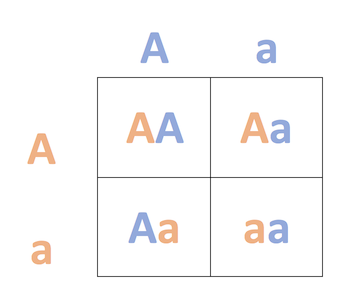
If we complete the cross, we find that the possible offspring can be AA, Aa, or aa. Offspring that have an A allele must have pea combs, because the allele for pea combs (A) is dominant to the allele for single combs (a). Only aa offspring will have single combs.
-
If we look at our Punnett square, we find that there is a 1/4 chance of offspring having the genotype for single combs (aa). If we convert this to a percentage, it means there is a 25% chance these parents will have offspring with single combs.
-
The correct answer is
25%
-
Query \(\PageIndex{7}\)
- Step-by-step solution
-
-
Because there are two traits here, we must perform a dihybrid cross. We know the parent genotypes (SsTt and SsTt), but we need to figure out what the possible gametes are by figuring out all the possible combinations of the two alleles.
For both parents, the SsTt genotype leads to the possible gamete combinations of ST, St, sT, or st.
-
Next we will perform the dihybrid cross.
Cross: SsTt x SsTt

After completing the cross, we need to figure out how many of the offspring genotype combinations contain two recessive s alleles and at least one dominant T allele in order to get the sassy and timely phenotype combination.
-
Because we are looking for the proportion of offspring that are both sassy and timely, we can refer to the circled genotypes in \({\color{Red} red}\) on the Punnett square. These boxes all contain two recessive s alleles and at least one dominant T allele.
Overall, there are 3 \({\color{Red} red}\) circled genotypes and thus, a 3/16 chance of offspring being sassy and timely. When converted to a percentage, 3/16 = 18.75%.
-
The correct answer is
-
Query \(\PageIndex{8}\)
- Step-by-step solution
-
-
When a dominant allele is present, it will be expressed. Both parents are heterozygous (Kk), meaning that each will have smooth kernels because of the K allele.
The cross for these parents is Kk x Kk.
-
We can complete a Punnett square to find the possible offspring combinations.
Cross: Kk x Kk

If we complete the cross, we find that the possible offspring can be KK, Kk, or kk. Offspring that have a K allele must have smooth kernels because the allele for smooth kernels (K) is dominant to the allele for wrinkled kernels (k). Only kk offspring will have wrinkled kernels.
-
If we look at our Punnett square, we find that there is a 1/4 chance of offspring being homozygous dominant for smooth kernels (KK) and a 2/4 chance of that the offspring will be heterozygous (Kk) for smooth kernels.
Combined, we find that there is a 3/4 chance that the offspring will have smooth kernels.
-
The correct answer is
3/4
-
Query \(\PageIndex{9}\)
- Step-by-step solution
-
-
Because there are two traits here, we must perform a dihybrid cross. We know the parent genotypes (AABb and aabb), but we need to figure out what the possible gametes are by figuring out all the possible combinations of the two alleles.
For the AABb parent, the possible gamete combinations are AB, AB, Ab, or Ab.
For the aabb parent, the possible gamete combinations are ab, ab, ab, or ab.
-
Next, we will perform the dihybrid cross.
Cross: AABb x aabb
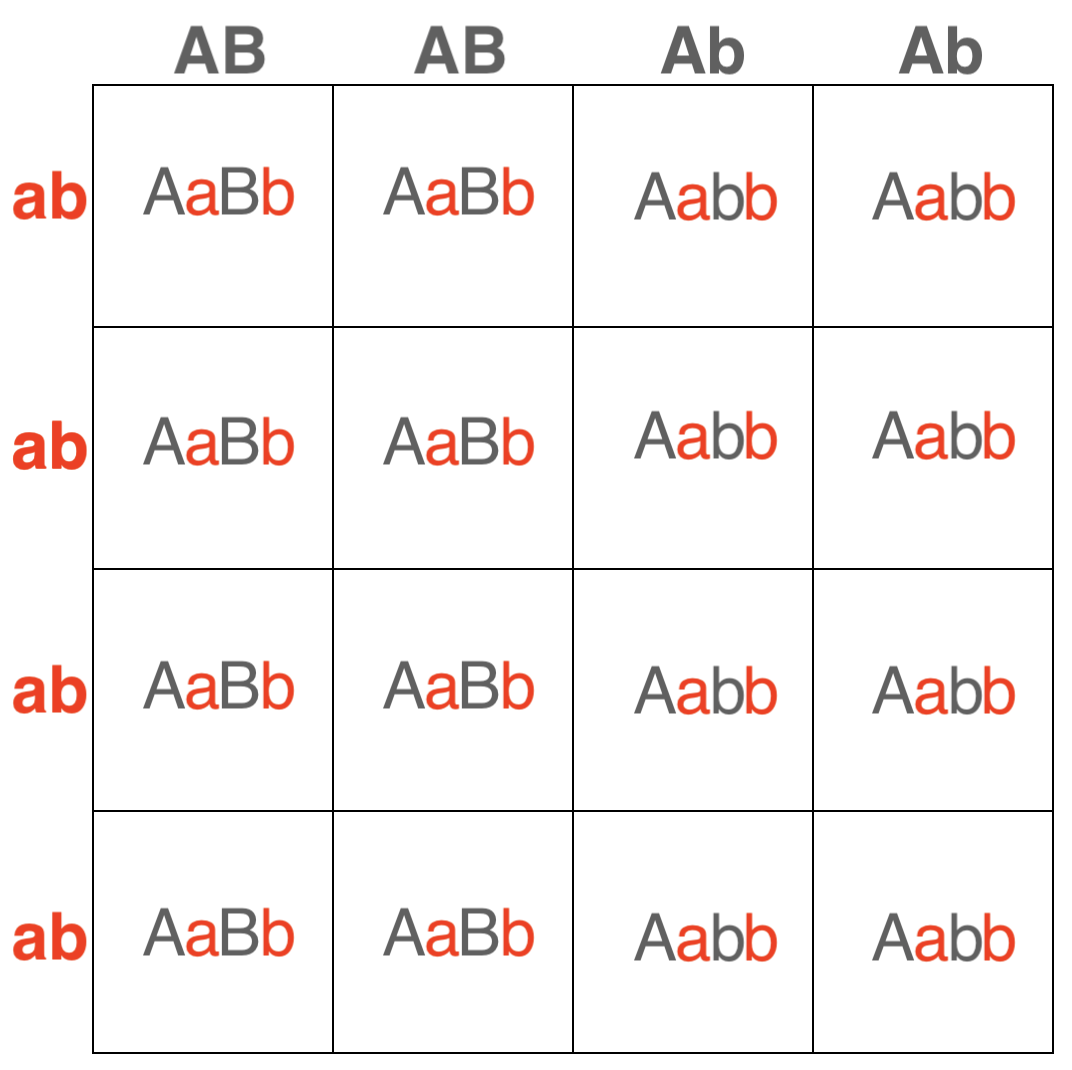
By completing the cross, we find that the possible offspring genotypes are AaBb or Aabb.
-
Because we are looking for the proportion of offspring that are heterozygous for both traits, we need to identify offspring that are heterozygous for the awesome trait (Aa) and heterozygous for the bashful trait (Bb).
If we look at our Punnett square, the only dihybrid genotype that is heterozygous for both traits is AaBb.
There is an 8/16 chance of offspring being awesome and bashful, or heterozygous for both traits with the genotype AaBb.
8/16 = 1/2 = 50%
-
The correct answer is
50%
-
Query \(\PageIndex{10}\)
- Step-by-step solution
-
-
The homozygous black horse has a genotype of BB. Homozygous means it has two of the same alleles, and it is black, so the allele is B.
The chestnut horse has a genotype of bb because it can only be chestnut if it has two recessive (b) alleles. If it had even one B allele, it would be black.
The cross for these parents is BB x bb.
-
We can complete a Punnett square to find the possible offspring combinations.
Cross: BB x bb
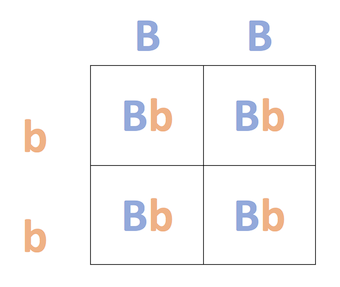
If we complete the cross, we find that the only possible offspring can only be Bb. Offspring that have a B allele must be black because the allele for black color (B) is dominant to the allele for chestnut color (b). So all of the offspring produced will be black.
-
If we look at our Punnett square, we find that there is a 0/4 chance of offspring being chestnut because Bb offspring will show the dominant trait (black). If we convert this to a percentage, it means there is a 0% chance these parents will have chestnut offspring.
-
The correct answer is
0%
-
Query \(\PageIndex{11}\)
- Step-by-step solution
-
-
Because there are two traits here, we must perform a dihybrid cross. We know the parent genotypes (Ttgg and ttGg), but we need to figure out what the possible gametes are by figuring out all the possible combinations of the two alleles.
For the Ttgg parent, the possible gamete combinations are Tg, Tg, tg, or tg.
For the ttGg parent, the possible gamete combinations are tG, tG, tg, or tg.
-
Next, we will perform the dihybrid cross.
Cross: Ttgg x ttGg

By completing the cross, we find that the possible offspring are TtGg, ttGg, Ttgg or ttgg.
-
Because we are looking for the proportion of offspring that are short with yellow peas, we know that we are looking for a fully recessive offspring, or offspring with a ttgg genotype.
If we look at our Punnett square, we find that there is a 4/16 chance of offspring being short with yellow peas, or ttgg. We can then reduce this chance to 1/4.
-
The correct answer is
1/4
-
Query \(\PageIndex{12}\)
- Step-by-step solution
-
-
The mother and father are both heterozygous, so they both can possibly give one of either allele (S or s) to the offspring. The cross for these parents is Ss x Ss.
-
We can complete a Punnett square to find the possible offspring genotypes.
Cross: Ss x Ss
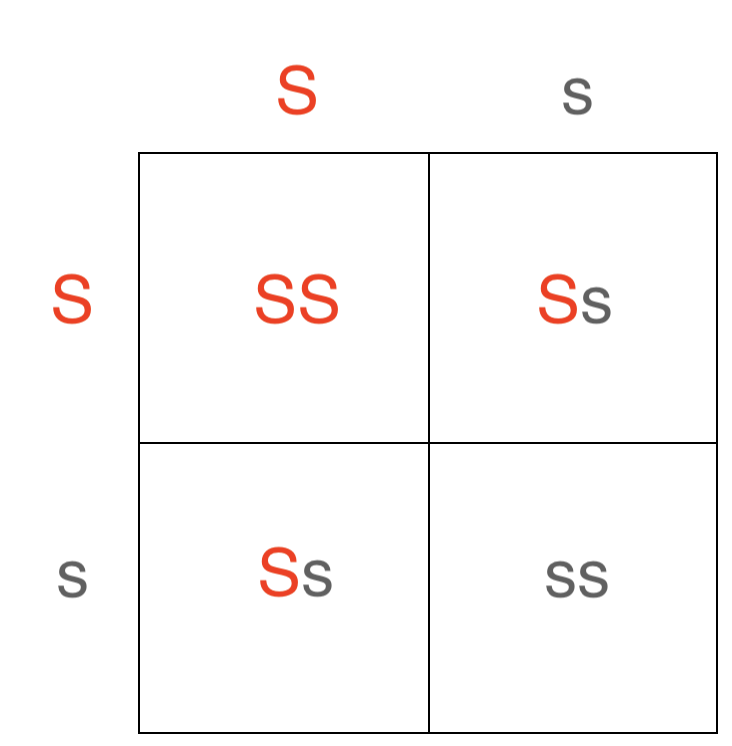
If we complete the cross, we find that the possible offspring can be SS, Ss, or ss. Offspring that have at least one dominant S allele must be healthy (no sickle-cell anemia) because the allele for healthy (S) is dominant to the allele for sickle-cell anemia (s). Only ss offspring will have sickle-cell anemia.
-
If we complete the cross, we find that there are 2/4 possible offspring genotypes that are heterozygous (Ss). We can then reduce this chance to 1/2.
-
The correct answer is
1/2
-
Contributors and Attributions
Khan Academy (CC BY-NC-SA 3.0; All Khan Academy content is available for free at www.khanacademy.org)

